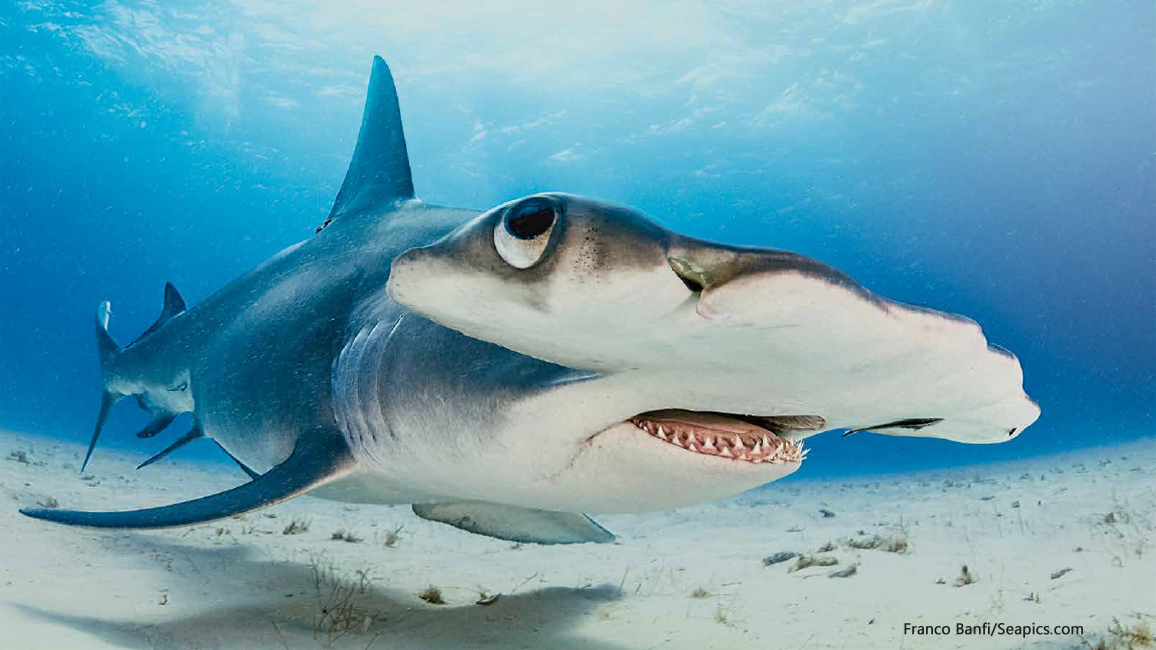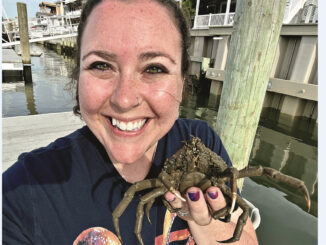
Do You Really Know Noses?
By Gerry BishopHere’s your chance to sniff out the whole story!
Take a minute to think about some yummy smells—such as the smoky aroma of frying bacon or the tangy scent of a freshly peeled orange. Our noses are great at sniffing out all kinds of good things to eat.
Other animals also use their noses to catch the scents of tasty meals. In fact, most of them have a much better sense of smell for this than we do.
Take this hammerhead shark. Like most other sharks, it can smell a meal from miles away. But unlike other sharks, hammerheads have super-wide heads with far-apart nostrils. Scientists think these features help hammerheads better tell where a smell is coming from. You’ll find more animals that have super-sniffers on the following pages. But first, check out the mole (above right). It’s just one of the many animals you’ll meet with noses that do something other than smell.
Feeling for a Meal
Look at the schnoz on this star-nosed mole! It’s covered with 22 soft, pink tendrils used for feeling, not smelling. As the mole digs through the wet ground, its tendrils quickly touch everything in front of it, feeling for worms, beetles, and other delicious snacks.
Better Than a Bloodhound
Bloodhounds are the super-sniffers of the dog world. But bears have a sense of smell that may be many times better. This grizzly bear, for example, can pick up the scent of a dead deer a mile away. It can also sniff out and dig up ground squirrels and other prey hiding deep underground.
Getting the Scoop
An albatross (AL-buh-tross) soars above ocean waves, searching for fish, squid, and other prey. Good things to eat are scattered far and wide in the ocean. If the bird depended on just its eyesight, it might not find enough to eat. Its super-powerful sense of smell makes all the difference.
This sense of smell is boosted by two tube-like nostrils on top of the albatross’s bill. The tubes scoop up air and send it to the scent detectors inside the bird’s head. There, the faintest smells deliver a clear and strong message: Keep heading this way for something good to eat!
Sniffing Ąround
This mother giant anteater wanders across a grassland in South America, sniffing for a nest of tasty ants or termites. She has a sense of smell that’s 40 times better than a person’s. How will she get at the insects in a nest? First, she’ll use her sharp claws to dig out a hole in the nest. Then she’ll poke her snout inside and—with quick darts of her long, sticky tongue—slurp up a yummy meal.
Getting the Message Out, Loud and Clear
How do you turn a soft hiss into a loud buzz? Just blow through a “boom box” on the end of your nose. That’s how a male gavial (GAY-vee-uhl) does it. And why would he want to do such a thing? To warn other males to stay out of his territory and to invite females in.
Taking Ąim
A bat sends out loud chirps through its nose. The chirps bounce off objects in front of it and return to the bat’s ears as echoes. By listening for the echoes, the bat can track down prey.
Scientists think the “leaf” around the nose of this ghost bat may help it aim the outgoing chirps.
Drilling Down
The long, thin snout of a weevil is for feeding, not sniffing. When this chestnut weevil finds a chestnut or an acorn, it uses the two tiny jaws at the end of its long snout to chew through the nut’s shell and into the tasty “meat” that’s inside.
The story doesn’t end here for a female. She uses her extra-long snout to dig as deep as possible into the nut. Then she turns around and lays an egg in the hole. Later, the egg will hatch into a worm-like larva and have lots of nutmeat to eat.
Closed— Keep Out!
The shovel-nosed treefrog uses its hard, bony nose and head as a door! The frog lives where the weather can get too hot and dry. When that happens, the tiny frog hops into a tree hole, turns around, and jams its head into the opening. By “closing the door” on hot, dry air, it stays cool and comfy.
Living Toolbox
An elephant’s trunk might be THE most amazing nose. It’s packed with 40,000 muscles. (Your whole body contains only 639.) That makes it strong enough to tear down a tree or to lift almost 800 pounds. It’s also nimble enough to pick up a blade of grass.
Elephants use their noses for other things, too. At left, two elephants are showing their friendship by rubbing their trunks together.
Great Snorkel
When an elephant has to cross a deep river, it walks along the river bottom with just the end of its trunk above water. An elephant’s nostrils are at the tip of its trunk, so the animal can breathe just fine this way.
Handy Hose
Time for a bath? All an elephant has to do is snort some water or dust into its trunk and blast it onto its body. And when it needs a drink, it sucks as much as eight gallons of water into its trunk and squirts it into its mouth.
As you can see, animal noses are for wa-a-ay more than just smelling!
“Do You Really Know Noses?” appears in the May 2018 issue of Ranger Rick magazine.
(Click on each image above for a closer view of the story.)




















